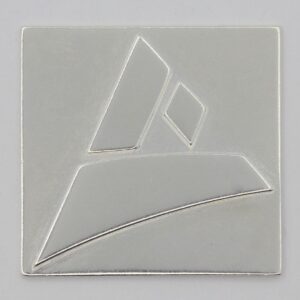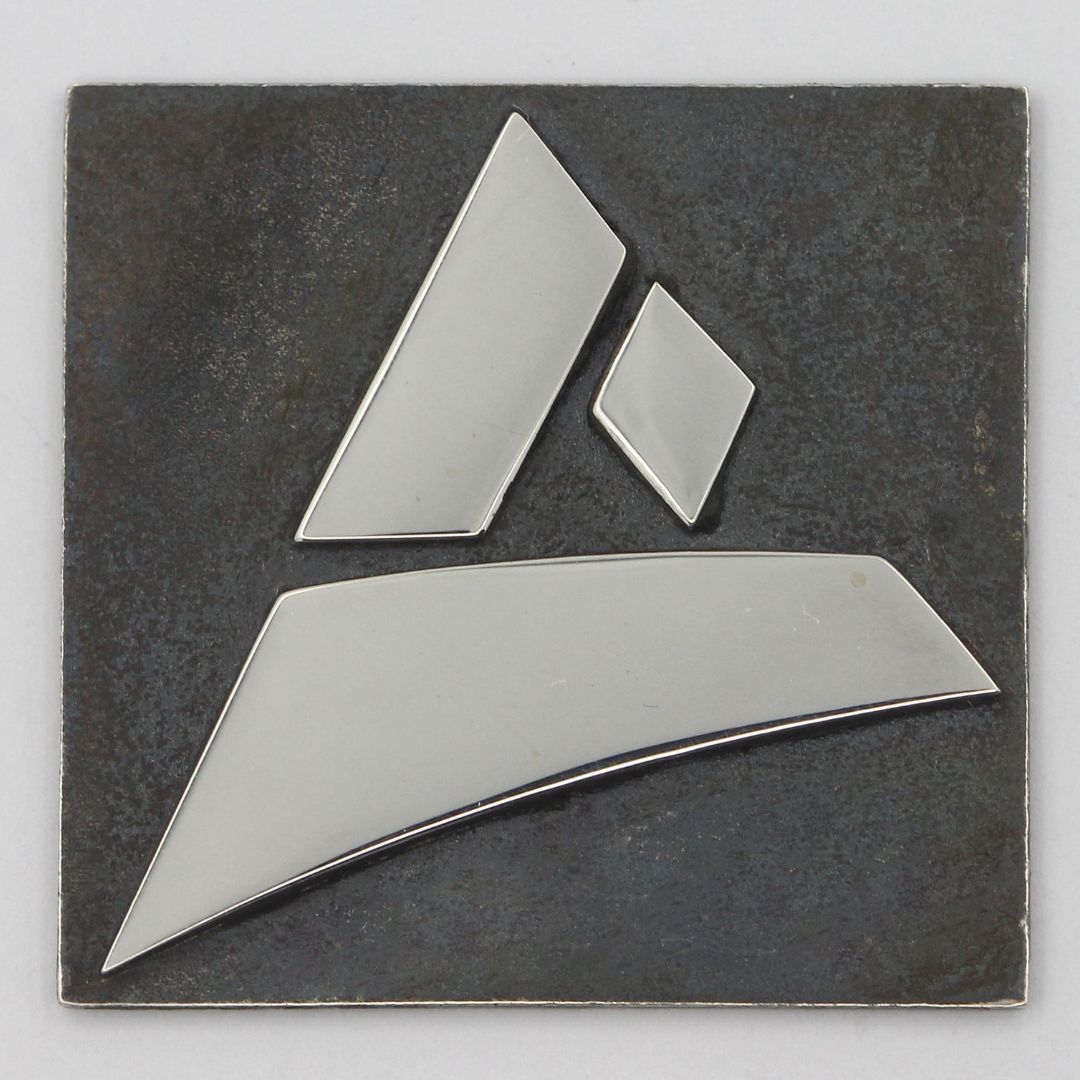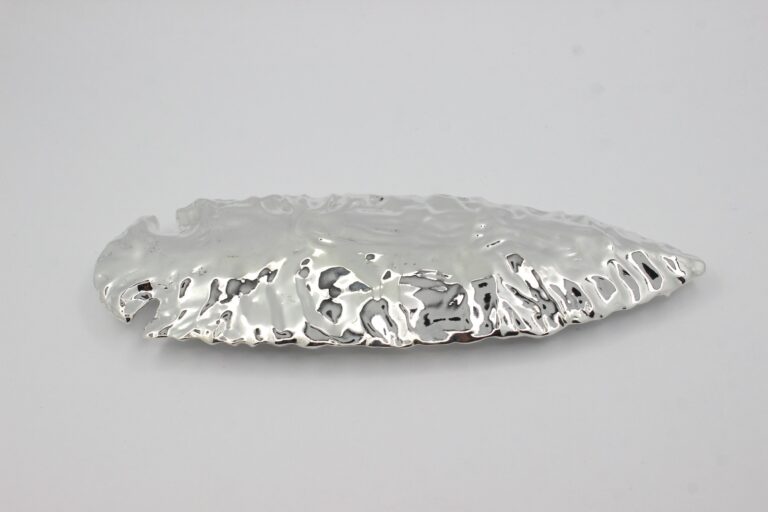Silver has been used in jewelry for millennia. Pure silver (99.9% Ag) is very soft, so most jewelry is made from Sterling Silver, which is 92.5% silver alloyed typically with 7.5% copper for added strength.
Cast sterling silver is extremely common in jewelry, from fine artisan pieces to mass-produced items, due to its beautiful luster and workability. Let’s examine its properties:

Properties of Silver
| Color: | Bright white, reflective |
| Hardness (Mohs): | ~2.7-3.0 Mohs |
| Melting Point: | 893 °C (Sterling Silver) |
| Tensile Strength: | 170 – 250 MPa (annealed to hardened |
| Density: | ~10.3 g/cm³ |
Why Silver Is Ideal for Lost Wax Casting
Sterling silver is one of the most cast-friendly precious metals available. It flows well into molds, captures intricate features, and polishes to a mirror finish. With proper sprue and cooling setup, silver can handle delicate filigree, engraving, or sculpted textures.
Casting Advantages:
Great detail resolution
Smooth surface finish
Ideal for small and medium-volume designs
Easy to polish, oxidize, or plate (e.g., rhodium)
Considerations: Silver cools rapidly and has high thermal conductivity, meaning thin parts might solidify before the mold fills completely. Vacuum or centrifugal casting is recommended for fine features.




Hardness & Strength
Sterling silver is on the softer end of jewelry metals. On the Mohs scale it’s about 2.7–3.0 (pure silver is ~2.5). The small addition of copper brings sterling up to roughly Mohs 2.7 – still softer than brass, bronze, or 14K gold. In practical terms, silver jewelry scratches and nicks fairly easily. Rings and bracelets in silver will quickly accumulate fine scratches with daily wear. However, one advantage of silver’s softness is it can be easily re-polished and buffed to look like new, albeit with some metal loss over decades of polishing. Silver is also not as strong (in tensile strength) as harder alloys; thin silver pieces can bend or deform if pressure is applied.
Hardness comparison: for context, sterling silver has Vickers hardness around 60–100 HV annealed, whereas 14K gold might be ~120 HV and platinum alloys ~100–130 HV – so silver is on the low side of hardness among jewelry metals. It’s generally harder than pure 24K gold, but softer than most other jewelry alloys. That said, if designed with sufficient thickness, sterling silver jewelry can absolutely last a lifetime of daily use. Many vintage family jewelry pieces (lockets, flatware, etc.) survive generations, albeit often with some dents or wear. Key point: sterling silver is more prone to bending or wearing down over time compared to harder metals, so design and wear it with that in mind.
Corrosion & Tarnish
Silver is a noble metal, so it doesn’t “rust” or corrode in the typical sense, but it does tarnish readily. Tarnish is the gradual formation of silver sulfide on the surface, often appearing as a dull gray or black film. Exposure to sulfur compounds in the air (or from things like eggs, rubber bands, certain papers) accelerates this. Sterling silver tarnishes faster than pure silver because the copper in the alloy can oxidize too, contributing to darkening. Without maintenance, silver jewelry can turn quite dark over months or years. The good news is tarnish is just a surface effect and can be polished off, restoring the shine. Many silver jewelry pieces are rhodium-plated (a thin rhodium coating) to prevent tarnish and give a bright white finish. If your silver is rhodium-plated, it will resist tarnishing until the rhodium wears off. In daily use, expect to wipe your silver jewelry with a soft cloth periodically and give it a full polish every so often to keep it lustrous. Storing silver in anti-tarnish bags or using silica gel in your jewelry box can also slow tarnishing.
Hypoallergenic?
Sterling silver is generally considered a hypoallergenic metal for most people. It’s nickel-free (standard sterling is just silver and copper), and allergies to silver or copper are extremely rare. Nearly all wearers can tolerate sterling silver against the skin without issues. The “green finger” effect some experience with cheap silver rings is usually due to either a reaction with copper (in very acidic skin, a faint green/blue stain can occur) or from an undisclosed metal in low-quality “silver” (some inexpensive jewelry isn’t true sterling and may have nickel). True sterling silver from reputable sources should be safe – it’s one of the top recommended metals for sensitive skin, after platinum and high-purity gold. One caveat: if silver is plated (with nickel or another metal) or if it’s only silver-plated (with a base metal underneath), then allergy issues can arise when the plating wears. But solid sterling is a safe bet. Do note that tarnish (silver sulfide) can sometimes irritate skin slightly or leave a black smudge, but that’s not an allergy, just a chemical residue.
Everyday Use
Silver is widely used for everyday jewelry – think of all the sterling silver rings, chains, and earrings people wear daily. It is durable enough for daily wear, but remember it will scratch and tarnish, so it might not look pristine without upkeep. For something like an engagement ring or a piece you never take off, sterling silver is not usually preferred (white gold or platinum hold up better long-term in that context). But for things like earrings, pendants, or occasional-wear rings, silver is fine. Over many years, a very thin silver ring can wear quite a bit (even to the point of breaking) due to constant friction – e.g. old thin silver bands can thin out noticeably. So if longevity with heavy wear is the goal, ensure the design has sufficient heft. Practical examples: Sterling silver is common in artisan rings, engraved pendants, cuff bracelets, and fashion jewelry. Many designers use silver as a more affordable alternative to white gold. With proper care (keeping it clean and polished, avoiding sulfur exposure), silver jewelry stays beautiful. It’s also easy for any jeweler to repair or refinish because of its workability.
Care & Maintenance
Cleaning: Use a soft, dry cloth to remove oils, sweat, and moisture after each use. For deeper tarnish, clean with mild soap and warm water, then dry thoroughly. Avoid abrasive cleaners or brushes, as they can scratch soft silver surfaces.
Polishing: Use a silver polishing cloth to maintain brightness. For antique or oxidized finishes: do not polish the recessed areas, as this will remove the desired patina.
Storage: Store in a dry place, ideally wrapped in soft cloth to avoid scratches. Keep silver away from perfumes, lotions, cleaning products, and chlorine, as they accelerate tarnishing. Keep pieces separate to avoid scratches.
- Rodium plated silver: Clean with a soft cloth only, do not use polish (as it can wear away the rhodium layer). Once the plating wears off, typically after 1–2 years of daily use, it can be replated by a jeweler.
Design & Casting
Silver has a relatively low melting point (~893 °C for sterling) and casts very well, which is why lost-wax casting of silver is a staple of jewelry making. It can capture very fine details. However, one challenge in casting silver is its high thermal conductivity – it cools quickly, so very thin sections might solidify before filling completely. Jewelry casters mitigate this with proper sprue design and sometimes centrifugal or vacuum casting for thin parts. From a design perspective, remember that silver’s softness means delicate details can wear down. Intricate patterns on a ring’s surface, for example, may blur out from years of tiny scratches and polishing. Also, avoid ultra-thin structural elements in silver – e.g., prongs holding stones should be a bit thicker than they would be if made in harder metal like white gold, to avoid bending. Many mass-produced silver designs have slightly chunky prongs or bands for this reason.
Designer Tip 💡
Plan for thickness and support. Sterling silver needs at least 0.8 mm wall thickness (and 1 mm is better for rings) to avoid bending or breakage. Thin wires or prongs under ~0.8 mm diameter are likely to deform or snap with wear. If your piece has fine filigree or openwork, ensure there are enough structural supports. Also consider surface finishes: high-polish sterling is gorgeous but shows scratches quickly; a matte or oxidized finish can hide wear. Many designers oxidize (antique) silver deliberately – darkening the recesses – which both looks vintage and pre-empts the uneven tarnish issue. If a bright white look is desired, think about rhodium plating the finished silver piece (common for silver and white gold jewelry). Rhodium plating will prevent tarnish and add scratch-resistant surface hardness, though it adds cost and will wear off in a couple of years on rings. In summary, use silver for its beauty and workability, but design with its softness in mind: don’t go too thin, and expect to do finishing touches (polishing, plating) to keep it looking its best.
Silver Finishes Available at Castimize
We offer a selection of silver finishes to match your design intent:
Natural Silver: Matte, tumbled finish showing raw casting texture
Polished Silver: Bright and reflective, hand-polished for brilliance
Antique Silver: Chemically darkened in recessed areas for vintage contrast
Rhodium-Plated Silver: Brilliant white with added scratch and tarnish resistance
Ready to create in Silver? Upload your 3D Design
Custom metal casting in gold, silver & more.
High quality, fair prices, worldwide shipping. 🌍

FAQ
Is silver good for everyday jewelry?
Yes, sterling silver is suitable for daily wear, especially for earrings, pendants, and casual rings. However, because it’s a soft metal, it can scratch and tarnish over time. Regular cleaning and proper storage help maintain its appearance.
Is silver hypoallergenic?
Generally, yes. Sterling silver is nickel-free and safe for most people. Some wearers with highly acidic skin may see green discoloration from the copper content, but this is a harmless surface reaction, not an allergy.
Does sterling silver tarnish?
Yes. Sterling silver tarnishes due to exposure to air and sulfur compounds, forming a dark layer of silver sulfide. Tarnish is not permanent: it can be easily removed with polishing. Rhodium plating can prevent tarnishing for longer.
What is the best finish for sterling silver?
A high-polish finish brings out silver’s natural luster, but it shows scratches more easily. Oxidized finishes help hide wear and create an antique look. For long-lasting brightness, rhodium-plated silver is a great option.
Will sterling silver bend or break?
Sterling silver is soft compared to other metals, so very thin parts (like prongs or delicate wires) can bend or break under pressure. At Castimize, we recommend minimum wall thicknesses of 0.8–1.0 mm for structural parts.
How do I prevent tarnish on silver jewelry?
Store in anti-tarnish bags or boxes
Avoid moisture and air exposure
Wipe after each wear
Consider rhodium plating if you want low-maintenance silver
Explore Materials
- Gold Casting Guide
- Silver Casting Guide
- Brass Casting Guide
- Bronze Casting Guide
- Plated Brass Guide
- Platinum Casting Guide

